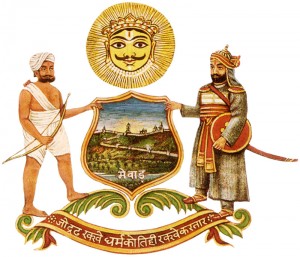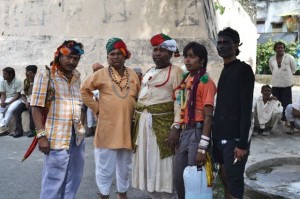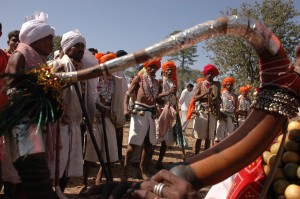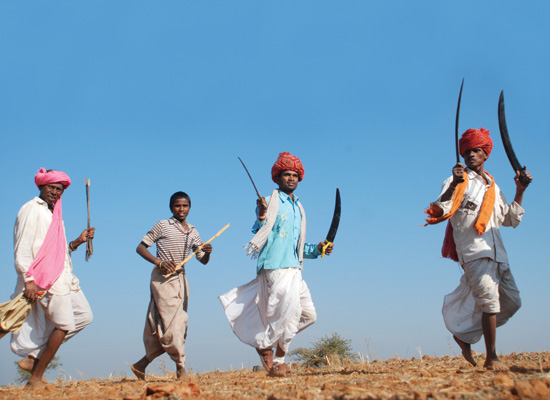 To anybody familiar with Hindu lore, the Bhils need no introduction. These forest folk have dwelt in the forests of central, northern and western India for thousands of years.
To anybody familiar with Hindu lore, the Bhils need no introduction. These forest folk have dwelt in the forests of central, northern and western India for thousands of years.
They are mentioned in the Ramayana and Mahabharata. In the Ramayana, a Bhil king acted as boatsman to Rama in the early part of his exile from Ayodhya.Shabari, the famous devotee of Rama, also belonged to the Bhil community.
She lived her life in the expectation that the Avatar would visit her one day ??? and indeed he did, eating the berries she had collected for him.
 The Bhils are probably the oldest community of the forests. They can be fearsome ??? and never let a trespasser cross their land without inflicting a serious injury on them. Even today, a war-cry (kilki) from a Bhil would cause hundreds of Bhil youths to gather within minutes!Bhils have been a part of the Hindu world through the ages, and have on several occasions been distinguished by their valour.
The Bhils are probably the oldest community of the forests. They can be fearsome ??? and never let a trespasser cross their land without inflicting a serious injury on them. Even today, a war-cry (kilki) from a Bhil would cause hundreds of Bhil youths to gather within minutes!Bhils have been a part of the Hindu world through the ages, and have on several occasions been distinguished by their valour.
A relatively recent example of this is in the aid that they gave to the famous Rajput king of Mewar (in modern Rajisthan), Rana Pratap Singh (1540-1597), in his battles to maintain independence against the Moghul Emperor Akbar. Most other Rajput rulers had taken the position of vassals of the Moghuls, but Rana Pratap, like his father and grandfather, was unwilling to compromise his absolute independence from the Moghuls.
 Rana Pratap???s dangerous career, which culminated in eventual victory, was only possible due to the help he received from the Bhils, who were one of the 2 pillars of his strength (the other being his loyal Rajput soldiers). The state emblem of Mewar till today bears testimony to the respect given to the Bhils, where Rana Pratap and a Bhil are shown standing on either side of the Eklingji (the titular deity of Mewar).After the Battle of Haldighati in 1576, where a 10,000 strong Moghul force narowly defeated the 3,000 man Rajput and Bhil combine, Rana Pratap was forced to retreat and resort to gurilla resistence for the next 2 years, while the Moghuls attempted to hunt him down.
Rana Pratap???s dangerous career, which culminated in eventual victory, was only possible due to the help he received from the Bhils, who were one of the 2 pillars of his strength (the other being his loyal Rajput soldiers). The state emblem of Mewar till today bears testimony to the respect given to the Bhils, where Rana Pratap and a Bhil are shown standing on either side of the Eklingji (the titular deity of Mewar).After the Battle of Haldighati in 1576, where a 10,000 strong Moghul force narowly defeated the 3,000 man Rajput and Bhil combine, Rana Pratap was forced to retreat and resort to gurilla resistence for the next 2 years, while the Moghuls attempted to hunt him down.
 In these years, Rana Pratap suffered enormous hardships, but the assistance of the Bhil chiefs enabled him to keep up resistance. The Bhils fought on foot ??? they had no horses. They specialised in guerilla warfare. Their needs were few. They desired no salary. In times of war they were given food and their basic necessities, but they participated and helped in campaigns as a matter of love and duty rather than for any gain (unlike so many other greedy Hindu mercenaries of the medieval ages).
In these years, Rana Pratap suffered enormous hardships, but the assistance of the Bhil chiefs enabled him to keep up resistance. The Bhils fought on foot ??? they had no horses. They specialised in guerilla warfare. Their needs were few. They desired no salary. In times of war they were given food and their basic necessities, but they participated and helped in campaigns as a matter of love and duty rather than for any gain (unlike so many other greedy Hindu mercenaries of the medieval ages).
 Their martial qualities ??? their habit of climbing hills, jumping over thorny bushes with ease and bearing what others would deem as immense discomfort without difficulty, were their special qualities. After the Battle of Haldighat, every attempt was made to pursue and capture Rana Pratap, and the only way he managed to evade capture and keep up the fight was the help of the skillful Bhils.
Their martial qualities ??? their habit of climbing hills, jumping over thorny bushes with ease and bearing what others would deem as immense discomfort without difficulty, were their special qualities. After the Battle of Haldighat, every attempt was made to pursue and capture Rana Pratap, and the only way he managed to evade capture and keep up the fight was the help of the skillful Bhils.
 The Rajputs and Bhils jointly took a vow that they would forego all comforts until they had freed their kingdom. With their help, Rana Pratap was able to regain most of is kingdom from 1579 onwards.Today, Bhils occupy varying professions, ranging from wild hunters to orderly and hardworking peasants. In recent years, some Bhils can also be found living a city lifestyle (although very few only). The typical Bhil is short, dark and well built. the men typically dress with a piece of loose cloth around their heads and a loin cloth of limited length.
The Rajputs and Bhils jointly took a vow that they would forego all comforts until they had freed their kingdom. With their help, Rana Pratap was able to regain most of is kingdom from 1579 onwards.Today, Bhils occupy varying professions, ranging from wild hunters to orderly and hardworking peasants. In recent years, some Bhils can also be found living a city lifestyle (although very few only). The typical Bhil is short, dark and well built. the men typically dress with a piece of loose cloth around their heads and a loin cloth of limited length.
 The women dress in colourful garments and wear many rings and bangles. There are cases where Bhils have intermarried with Rajputs under necessity. For example, certain defeated Rajputs in the medieval ages would retreat to the forests and blend in with the tribals in order to avoid becoming the vassals of Muslim rulers. Therefore in some parts of India, Bhils share many Rajput customs.
The women dress in colourful garments and wear many rings and bangles. There are cases where Bhils have intermarried with Rajputs under necessity. For example, certain defeated Rajputs in the medieval ages would retreat to the forests and blend in with the tribals in order to avoid becoming the vassals of Muslim rulers. Therefore in some parts of India, Bhils share many Rajput customs.
 Mixed Bhil and Rajput tribes are called Bhilala and Bhumiar. Holi, Diwali and Akha Trij are the 3 destivals that the Bhils generally celebrate with great fervour. They are devotees of Lord rama, and worship various manifestations of the Goddess (Devi). Bhils have been quite secluded from mainstream society throughout the ages. Christian missionaries have been very active in trying to convert Bhils (as they do with tribal communities all over the world).
Mixed Bhil and Rajput tribes are called Bhilala and Bhumiar. Holi, Diwali and Akha Trij are the 3 destivals that the Bhils generally celebrate with great fervour. They are devotees of Lord rama, and worship various manifestations of the Goddess (Devi). Bhils have been quite secluded from mainstream society throughout the ages. Christian missionaries have been very active in trying to convert Bhils (as they do with tribal communities all over the world).
Despite this ??? relatively few Bhils have been converted, and urban Hindus have in recent years set up several projects for the service of the Bhil people.
Source: The Bhils: The Most Famous Hindu Tribal Warriors

